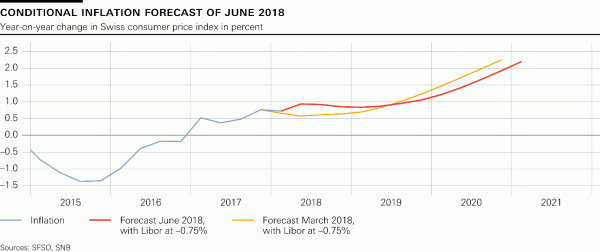SNB left monetary policy unchanged as widely expected. Sight deposit rate is held at -0.75%. Three-month Libor target range is kept at -1.25% to -0.25%.
SNB also pledge to stand by for intervention and “remain active in the foreign exchange market as necessary, while taking the overall currency situation into consideration”.
2018 inflation forecast was raised to 0.9%, up from March projection of 0.6%. That’s due to a “marked rise in the price of oil”.
2019 inflation forecast was kept unchanged at 0.9%. Though, from mid-2019, the new condition forecast is lowered due to “muted outlook in the euro area”.
For 2020, inflation forecast was lowered to 1.6%, down from March projection of 1.9%.
All the inflation forecasts were based on assumption the three month Libor remains at -0.75% over the entire forecast horizon.
On global growth, SNB expected economy to continue to grow above its potential. But risks are “more to the downside” due to “political developments in certain countries as well as potential international tensions and protectionist tendencies.”
Swiss GDP is projected to growth at around 2% in 208, unchanged. And unemployment is expected to fall further.
Swiss National Bank leaves expansionary monetary policy unchanged
The Swiss National Bank (SNB) is maintaining its expansionary monetary policy, thereby stabilising price developments and supporting economic activity. Interest on sight deposits at the SNB remains at −0.75% and the target range for the three-month Libor is unchanged at between −1.25% and −0.25%. The SNB will remain active in the foreign exchange market as necessary, while taking the overall currency situation into consideration.
All in all, the value of the Swiss franc has barely changed since the monetary policy assessment of March 2018. The currency remains highly valued. Following the March assessment, the Swiss franc initially depreciated slightly against the US dollar and the euro. However, in light of political uncertainty in Italy, we have since seen countermovement, particularly against the euro. The situation on the foreign exchange market thus remains fragile, and the negative interest rate and our willingness to intervene in the foreign exchange market as necessary therefore remain essential. These measures keep the attractiveness of Swiss franc investments low and ease pressure on the currency.
The new conditional inflation forecast for the coming quarters is slightly higher than it was in March 2018 due to a marked rise in the price of oil; this price rise ceases to affect annual inflation after the first quarter of 2019. From mid-2019, the new conditional forecast is lower than it was in March 2018, mainly due to the muted outlook in the euro area. At 0.9%, the inflation forecast for 2018 is 0.3 percentage points higher than projected at the March assessment. For 2019, the SNB continues to anticipate inflation of 0.9%. For 2020, we expect to see inflation of 1.6%, compared with 1.9% forecast in the last quarter. The conditional inflation forecast is based on the assumption that the three-month Libor remains at –0.75% over the entire forecast horizon.
Overall, global economic growth was solid in the first quarter. Growth in the US and China was strong and broad-based. The pace of economic expansion slowed in the euro area, however, albeit partly due to temporary factors. The economic signals for the coming months remain favourable. The SNB’s baseline scenario therefore assumes that the global economy will continue to grow above its potential.
The risks to the SNB’s baseline scenario are more to the downside. Chief among them are political developments in certain countries as well as potential international tensions and protectionist tendencies.
Switzerland’s economy continued to recover as expected, with GDP once again growing faster than estimated potential in the first quarter. Overall capacity utilisation improved further on the back of this positive development. The SNB still anticipates GDP growth of around 2% for the current year and expects to see unemployment falling further.
Imbalances on the mortgage and real estate markets persist. While growth in mortgage lending has been only moderate over the last few quarters, real estate prices have continued to rise. Particularly in the residential investment property segment, there is the risk of a correction due to the strong increase in prices in recent years. The SNB will continue to monitor developments on the mortgage and real estate markets closely, and will regularly reassess the need for an adjustment of the countercyclical capital buffer.
















